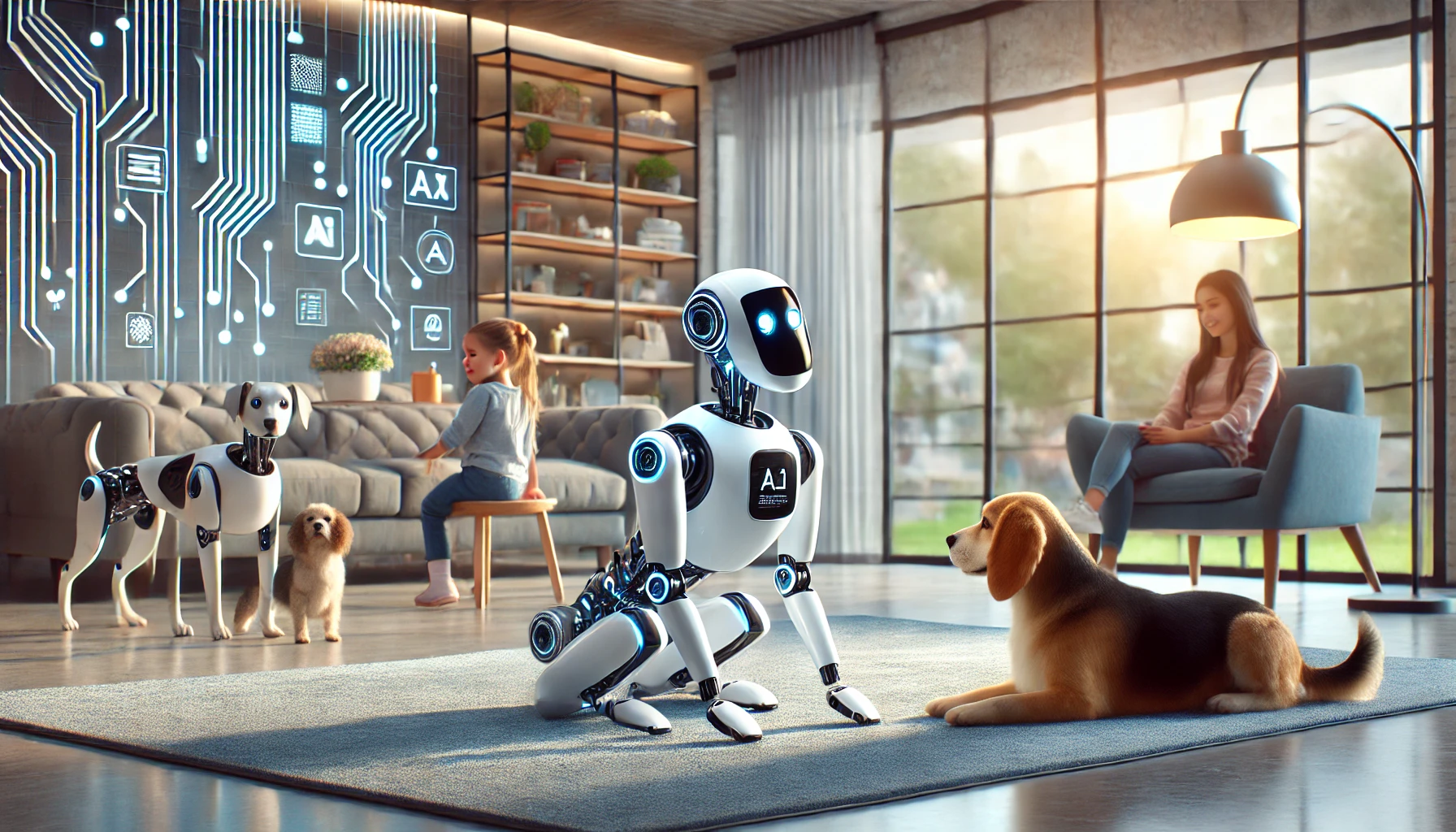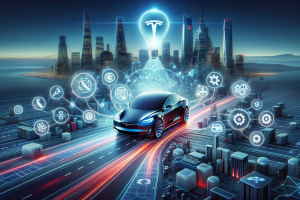AI-Powered Robotic Dogs: Features, Technology, and Future Potential
AI-Powered Robotic Dogs: In a world where technology is advancing at an unprecedented pace, AI-powered robotic dogs have emerged as a fascinating blend of innovation and companionship. These smart robot dogs are no longer just a figment of science fiction; they are now a reality, offering a glimpse into the future of AI-powered pets. Whether you’re curious about how they work, what they can do, or how much they cost, this comprehensive guide will explore all aspects of AI-powered robot dogs.
What Is an AI-Powered Robot Dog?
An AI-powered robot dog is a sophisticated robotic device designed to mimic the behavior and appearance of a real dog. These robots are equipped with advanced AI algorithms that enable them to perform various tasks, interact with their environment, and even display emotions. Unlike traditional robots, AI-powered robot dogs are designed to be more than just machines; they are intended to be companions that can learn, adapt, and respond to their owners in a way that feels natural and engaging.
Key Features of AI-Powered Robot Dogs
- Advanced AI Algorithms: These robots use complex AI to recognize voices, understand commands, and adapt their behavior based on user interaction. This allows them to perform a wide range of tasks, from basic tricks to more complex activities like navigating obstacles.
- High-Quality Sensors: Equipped with various sensors, including cameras, microphones, and touch sensors, AI-powered robot dogs can perceive their environment and respond accordingly. This sensory input is crucial for tasks like obstacle avoidance, interaction with humans, and environmental navigation.
- Voice and Gesture Recognition: Many robot dogs with AI come with voice and gesture recognition capabilities, enabling them to respond to commands and interact more naturally with their owners. This feature makes them feel more like a real pet.
- Emotional Intelligence: Some advanced models are designed to display emotions through facial expressions, sounds, and body language. This emotional intelligence allows the robot to react to situations in a way that is relatable and comforting to humans.
- Connectivity and Control: Most smart robot dogs can be controlled via smartphone apps, allowing users to customize their behavior, monitor their activities, and even control them remotely. This feature adds a layer of convenience and personalization.
Boston Dynamics Robot Dog: A Pioneer in AI Robotic Companions
When discussing AI-powered robot dogs, it’s impossible not to mention Boston Dynamics’ robot dog, Spot. Boston Dynamics has been a leader in robotics for years, and their robotic dog, Spot, is one of the most advanced AI-powered robot dogs available today.
Why Spot Stands Out
Spot is designed to perform a variety of tasks that go beyond mere companionship. It can navigate complex environments, climb stairs, and even open doors. Spot’s AI-powered robotic dog companion capabilities make it suitable for industrial applications, search and rescue missions, and even entertainment.
One of Spot’s most impressive features is its ability to interact with its surroundings autonomously. It uses AI to map its environment, avoid obstacles, and make decisions in real-time. This level of autonomy is what sets Spot apart from other robot dogs and makes it a pioneer in the field.
How Much Does a Robot Dog Cost? A Look at Robot Dog Prices
One of the most common questions people have about AI-powered robot dogs is, “How much do they cost?” The robot dog price can vary significantly depending on the model and its features.
Factors Influencing the Price
- Technology and Features: The more advanced the AI and the more features the robot dog has, the higher the price. For example, a robot dog with advanced sensors, AI capabilities, and emotional intelligence will cost more than a basic model.
- Brand and Manufacturer: Well-known brands like Boston Dynamics typically charge more for their products due to their reputation and the quality of their technology.
- Customization: Some robot dogs offer customization options, such as different behaviors, voices, and appearances. These customizations can add to the overall cost.
Price Range
- Basic Models: Basic AI-powered robot dogs, like those designed for children or as novelty items, can range from $100 to $500.
- Mid-Range Models: More advanced models with better AI, sensors, and interaction capabilities typically cost between $500 and $2,000.
- High-End Models: High-end robots like Boston Dynamics’ Spot can cost anywhere from $10,000 to $75,000, depending on the configuration and capabilities.
The Future of AI-Powered Robot Dogs as Home Companions
As technology continues to evolve, the potential for robotic dogs for home use is becoming increasingly realistic. These AI-powered pets offer several benefits that make them attractive to certain households.
Benefits of AI-Powered Robotic Dogs
- Low Maintenance: Unlike real dogs, AI-powered robot dogs don’t require feeding, grooming, or regular vet visits. This makes them an excellent option for people who want a pet without the responsibilities that come with owning a living animal.
- Allergy-Friendly: For individuals with allergies, an AI robot pet offers a way to experience the companionship of a dog without the associated allergens.
- Programmable Behavior: Owners can program their robot dogs to behave in specific ways, making them ideal for families with young children or elderly individuals who may need a gentle and predictable companion.
- Enhanced Security: Some robot dogs are equipped with cameras and sensors that can be used for home security. They can patrol your home, monitor for intruders, and even alert you to suspicious activity.
Potential Challenges
While the idea of a robotic dog for home use is appealing, there are some challenges to consider. One of the primary concerns is whether a robotic dog can truly replace the emotional connection people have with real pets. Additionally, the high cost of advanced models may be prohibitive for some consumers.
Robot Dog vs. Real Dog: Can AI Replace Man’s Best Friend?
The debate between a robot dog vs. real dog is one that is likely to continue as AI technology advances. While robotic dogs offer convenience and advanced features, they still lack some of the qualities that make real dogs such beloved companions.
Advantages of Real Dogs
- Emotional Connection: Real dogs form deep emotional bonds with their owners, something that AI, despite its advancements, still struggles to replicate fully.
- Unpredictability and Playfulness: Real dogs often surprise their owners with unexpected behaviors and playful antics, creating memorable experiences that a programmed robot dog might not be able to offer.
- Natural Healing: Studies have shown that interactions with real dogs can have therapeutic benefits, such as reducing stress and anxiety. This natural healing power is something that AI-powered robot dogs are not yet able to provide.
Advantages of Robot Dogs
- Consistency: Robot dogs behave predictably, which can be a comfort to those who prefer a stable and controlled environment.
- No Mess: One of the most significant benefits of a robot dog is the lack of mess. There’s no shedding, no need for bathroom breaks, and no destruction of furniture or belongings.
- Customizable Experience: With a robot dog, you can customize its personality, behavior, and even appearance, creating a companion tailored specifically to your preferences.
The Verdict
While AI-powered robot dogs offer many practical advantages, they still can’t completely replace the experience of owning a real dog. However, for those who are unable to care for a real pet due to allergies, time constraints, or living conditions, an AI-powered robot dog could be a viable and rewarding alternative.
The Future of AI-Powered Companionship
The world of AI-powered robot dogs is rapidly evolving, offering exciting possibilities for the future of pet ownership and companionship. With advancements in smart robot dog technology, we can expect these robotic pets to become even more lifelike, interactive, and integrated into our daily lives.
Whether you’re considering adding a robotic dog for home use or simply curious about the latest developments in AI technology, the potential for these AI companions is vast. As they continue to improve, AI-powered robot dogs may become a common sight in households around the world, offering a unique blend of technology and companionship that bridges the gap between machine and man’s best friend.
For more insights on the latest technological advancements, you can explore resources on Regent Studies. Additionally, you might want to check out detailed reviews and comparisons of various robot dogs available on the market here.
As we move forward into this exciting new era, the question remains: Will you embrace the future of AI-powered companionship with an AI-powered robot dog?




